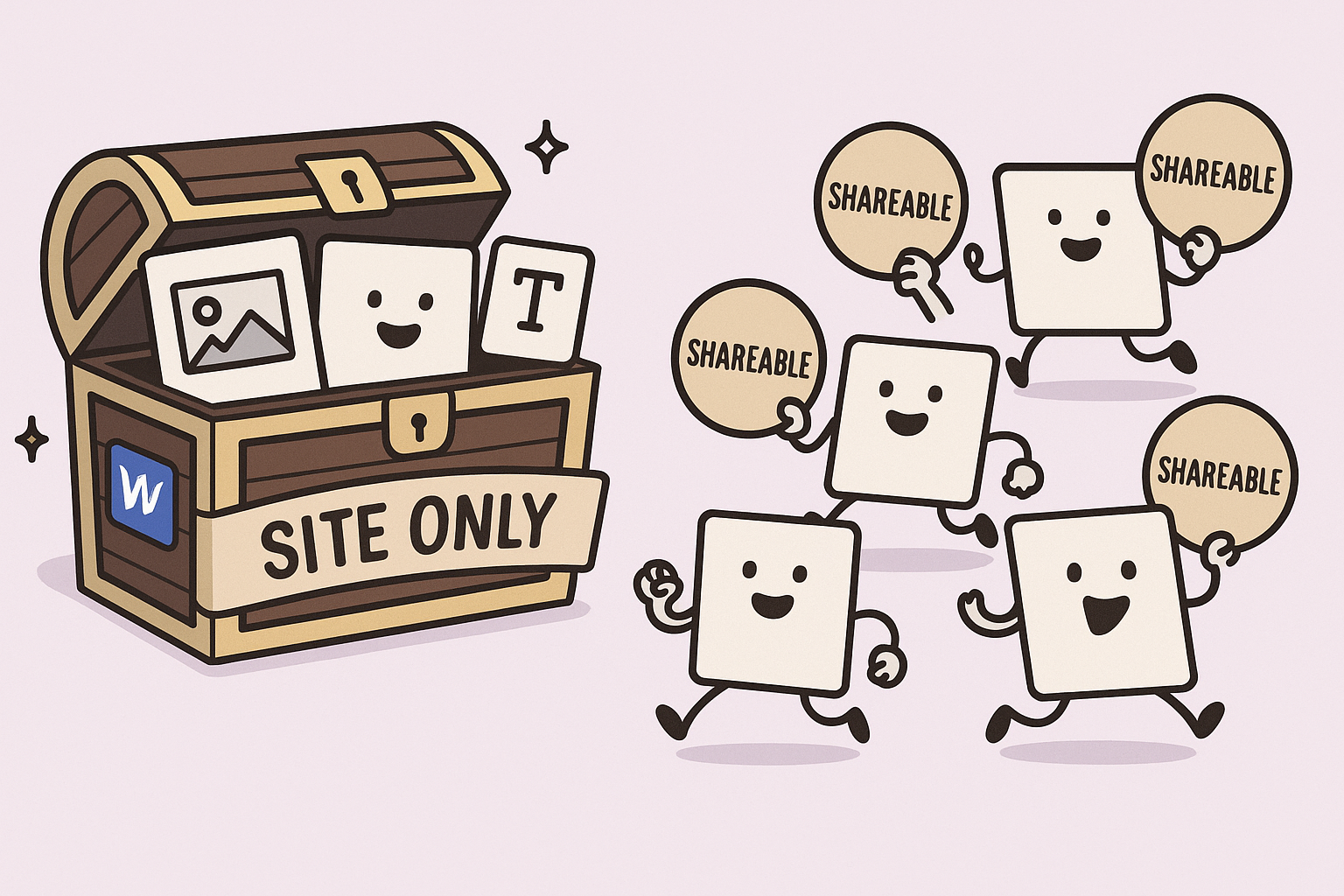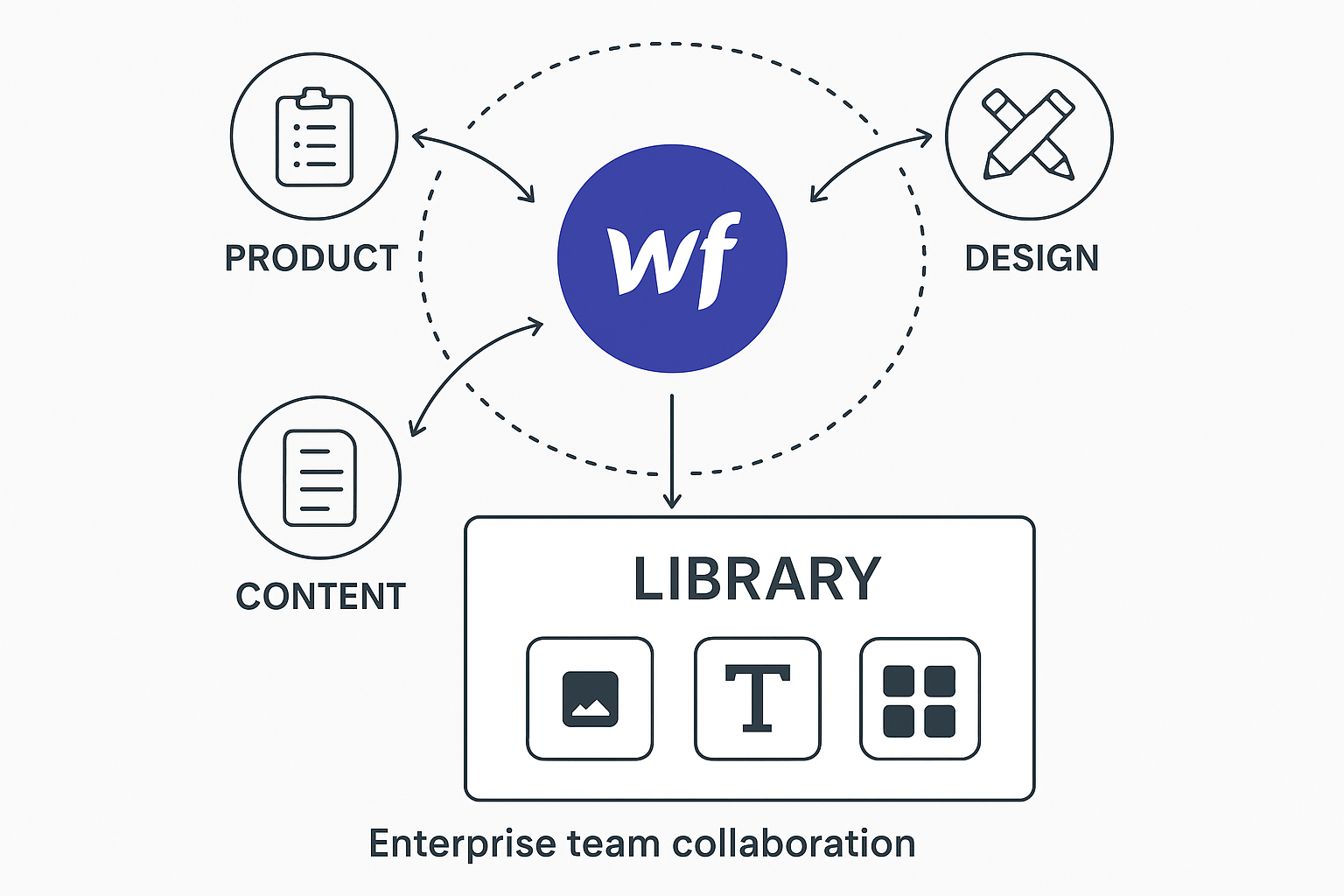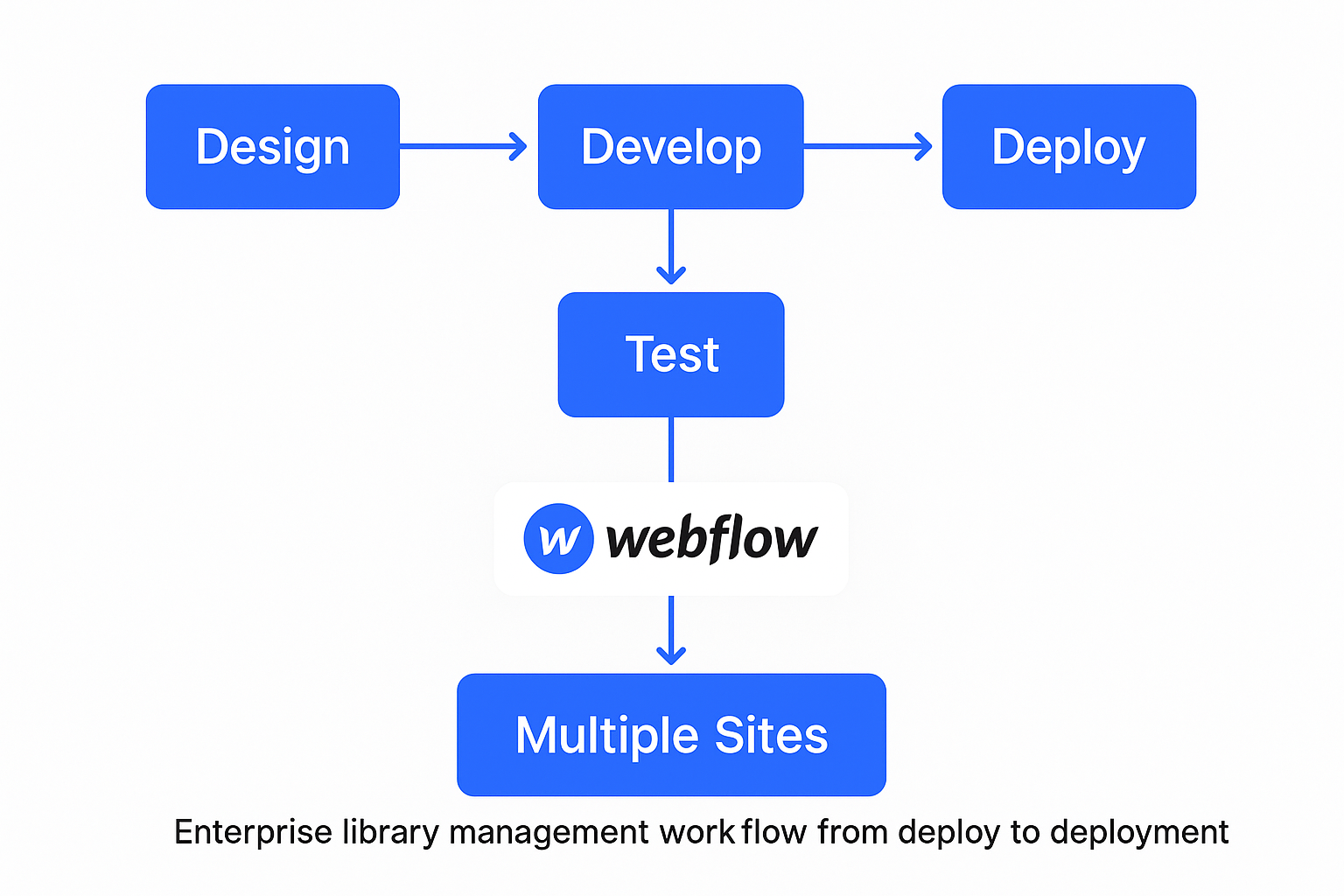Webflow Library Adventures 2025: One Master Library to Rule Them All (And Its Quirky Side)
- Published on
- • 14 mins read

Podcast: Webflow Library Experiments Explanation
By Lavkush Maurya [ Generated by LLM]
Introduction: My Webflow Library Experiment Journey 🎢
Webflow Library (now officially called Shared Libraries) is like that mate who's absolutely brilliant but has some very specific house rules. After months of experimenting with component sharing, workspace limitations, and enterprise scaling, I've discovered it's both a game-changer and a source of occasional head-scratching moments.
If you're curious about how Webflow Library works in 2025, from workspace restrictions to enterprise benefits, buckle up. This isn't just another tutorial—it's a real-world adventure story with practical insights that'll save you time and frustration.
The Master Library Rule: One Kingdom, One Crown 👑
Here's the fundamental truth about Webflow Shared Libraries: you can have only ONE master library per workspace. This isn't a limitation—it's actually brilliant design system architecture when you understand the reasoning.
How the One Master Library System Works
From your master library site, you can:
- Share components and variables across all projects in the same workspace
- Maintain brand consistency with a single source of truth
- Push updates to connected sites with change management workflows
- Include assets and variable modes for complete design system coverage
When I first created my master library, everything felt smooth sailing... until I tried sharing it outside the workspace. That's when Webflow politely informed me that my components are now unlinked.

The Science Behind One Library Per Workspace
This isn't arbitrary—it's enterprise-grade design system architecture. Here's why it matters:
Single Source of Truth: Prevents component chaos and version conflicts across multiple projects.
Change Management: Ensures controlled updates across all connected sites without breaking existing designs.
Brand Consistency: Maintains unified design language at scale for large organisations.
Performance Optimisation: Reduces loading times and asset duplication across your workspace.
The Great Workspace Migration Drama 🏋️
Moving your master library to another workspace? Oh, Webflow has some opinions about that. Instead of a simple drag-and-drop experience, you'll encounter this delightful message asking you to uninstall the library before moving.
Why Libraries Are Workspace-Bound
Think of your Webflow Library as that mate who loves hosting parties but refuses to leave their own house. They'll welcome everyone to their place, but don't expect them to relocate easily. Here's the technical reasoning:
Security Architecture: Libraries maintain workspace-level permissions and access controls that cannot be easily transferred.
Asset Dependencies: Shared assets and variables are tied to workspace infrastructure and moving disrupts these connections.
Collaboration Integrity: Moving libraries could break team workflows and component relationships built over time.
Version Control: Workspace boundaries ensure proper update management and prevent conflicts across different teams.
The Workaround Strategy
If you absolutely must move a library between workspaces, here's your battle plan:
Export Components: Use Webflow's component export feature before moving to preserve your work.
Recreate Library: Set up a fresh master library in the destination workspace from scratch.
Rebuild Connections: Install the new library across target sites manually.
Update References: Reconnect all component instances (this is the tedious part that'll test your patience).
Component Sharing: The Collection Conundrum 🧩
Here's where things get interesting (and occasionally frustrating). Webflow Library has specific rules about what you can and cannot share.
What Works Perfectly ✅
Standard Components: Buttons, cards, navigation bars, footers work like a charm in shared libraries.
Components with Embed Elements: Custom code and third-party integrations work perfectly without any issues.
Variable-Driven Components: Colour schemes, typography, and spacing systems share beautifully across projects.
Component Slots: Advanced modular components for flexible layouts that adapt to different content needs.
What Doesn't Work ❌
Components with Collection Lists: If your component contains CMS collection lists, it simply cannot be shared via library.
Collection-Bound Elements: Multi-reference fields and dynamic content blocks refuse to cooperate with sharing.
Form Elements within Components: Contact forms and lead capture components have significant limitations when sharing.
The Collection Limitation Explained
During my testing, I discovered that components containing collection lists can't be shared through Webflow Library. This happens because of several technical reasons:
Data Binding Conflicts: Collection lists are tied to specific CMS structures that vary between sites.
Dynamic Content Dependencies: Each site may have different collection schemas and field structures.
Performance Considerations: Sharing dynamic content could significantly impact loading speeds and site performance.

The Embed Element Exception
Interestingly, components with embed elements work perfectly in shared libraries. This means your custom JavaScript components, third-party widgets, analytics code blocks, and interactive elements all share without problems.
This exception exists because embed elements are self-contained and don't rely on site-specific data structures or CMS connections.
Component Slots: The 2025 Game-Changer 🎯
Component Slots represent the evolution of Webflow Library functionality. These allow you to create modular components with placeholders for dynamic content.
How Component Slots Transform Libraries
With Component Slots, you can create layout components with flexible content areas that adapt to different needs. You can build enterprise design systems with standardised templates that maintain consistency. These slots enable non-technical team members to build pages safely using pre-approved components. Most importantly, you maintain design consistency while allowing content flexibility.
Current Slot Limitations (2025)
Component slots cannot be placed inside collection items, link blocks, form blocks, rich text elements, or search elements. However, you can place components with slots into these elements, providing a workaround for many use cases.

Enterprise Benefits: Why Big Brands Love It 🏢
For enterprise organisations and large-scale brands, Webflow Library isn't just useful—it's transformational.
Scale Without Chaos
Enterprise teams using Webflow Library experience dramatically improved efficiency. Design inconsistencies across multiple sites reduce significantly because everyone uses the same components. Campaign launches happen much faster with pre-built component libraries ready to use. Brand guideline enforcement requires far less time and effort from design teams.
Real Enterprise Use Cases
Multiple Brand Management: Companies with subsidiary brands can maintain separate libraries whilst sharing core components across divisions.
Global Consistency: International enterprises use libraries to ensure brand alignment across different regions and locales.
Campaign Efficiency: Marketing teams can launch campaigns faster using pre-approved component libraries that maintain brand standards.
Developer Productivity: Engineering teams spend significantly less time on repetitive component creation and can focus on complex functionality.
Enterprise-Grade Features
Webflow Enterprise customers get unlimited shared libraries compared to just one library on Growth plans. They receive advanced security protocols for component access control. Custom workflow automation handles library updates seamlessly. Dedicated customer success support helps with library implementation and best practices.

The Learning Curve: Navigating Library Quirks 😂
Common Gotchas I've Encountered
Update Confusion: Remember it's a two-step process—first push updates from the master library, then accept them on individual sites.
Component Conversion: When transferring sites to clients, library components automatically convert to site components.
Notification Gaps: Currently, there's no automatic notification when library updates are available—teams need to check manually.
Permission Complexity: Understanding who can install, update, and manage libraries requires careful workspace role management.
Best Practices from the Trenches
Separate Design System Site: Create a dedicated site for your library instead of using your main production site.
Component Documentation: Use component descriptions and custom tooltips to guide team usage effectively.
Testing Environment: Always test library updates on a staging site before pushing changes to production.
Version Control: Maintain backup copies of critical components before making major updates.
Advanced Library Management Strategies 🚀
Multi-Site Architecture
For complex organisations, consider this hierarchical approach:
Master Design System Site: Contains core brand components that form the foundation of your design system.
Department-Specific Libraries: Specialised components for different teams like marketing, sales, or product.
Project Sites: Individual websites pulling from relevant libraries based on their specific needs.
Testing Environment: Dedicated space for component development and testing before deployment.
Change Management Workflows
Successful enterprise library management follows these essential steps:
Design Review: New components go through a thorough approval process before being added to libraries.
Testing Phase: Components undergo testing across different use cases and browser environments.
Documentation: Clear usage guidelines and practical examples are created for each component.
Staged Rollout: Updates are deployed to test sites first to identify any potential issues.
Production Push: Final updates are shared across all connected sites after successful testing.

Performance Optimisation with Libraries 📈
Speed Benefits
Webflow Libraries contribute to better site performance through several mechanisms. Asset Reuse means shared components reduce total asset loading across your websites. CDN Optimisation ensures common elements are cached across multiple sites for faster loading. Code Efficiency results in cleaner HTML output with standardised components. Reduced Redundancy eliminates duplicate CSS and JavaScript across your projects.
Scalability Advantages
Enterprise scalability improves significantly through consistent loading times achieved with standardised components. Global CDN distribution through Webflow's infrastructure supports worldwide access. Automatic optimisation includes built-in performance features that enhance user experience.
The Future of Webflow Libraries 🌟
Emerging Trends (2025)
AI-Powered Component Suggestions: Webflow's AI Assistant now helps optimise library components for better performance and usability.
Real-Time Collaboration: New collaborative editing features allow simultaneous library work without conflicts.
Enhanced Asset Management: Improved file organisation and version control for library assets makes management easier.
Advanced Variable Types: New Number and Percentage variables expand design system capabilities significantly.
What's Coming Next
Based on current development patterns, we can expect Cross-Workspace Library Sharing as a potential solution for agency workflows. Automated Conflict Resolution will provide better handling of component updates. Enhanced Collection Integration may offer possible workarounds for current collection limitations. Mobile-First Library Management will bring improved mobile editing capabilities.
Practical Implementation Guide 🛠️
Getting Started Checklist
Phase 1: Planning
- Audit existing components across your sites to identify patterns
- Identify reusable design patterns that appear consistently
- Plan your component naming convention for consistency
- Set up dedicated design system site for your library
Phase 2: Building
- Create core components like buttons, forms, and navigation
- Establish variable system for colours, typography, and spacing
- Add component descriptions and usage guidelines for team members
- Test components across different contexts and devices
Phase 3: Deployment
- Share library with workspace members
- Install library on pilot sites for testing
- Train team members on proper library usage
- Establish update review process for changes
Phase 4: Scaling
- Monitor component usage across sites regularly
- Gather feedback from team members about functionality
- Iterate on component designs based on real usage
- Expand library with new patterns as needs arise
My Honest Assessment: Love, Hate, and Laughs 😂
After months of Webflow Library experimentation, here's my candid take on the experience.
What I Love ❤️
Brand consistency achieved across multiple client sites has been remarkable. Development speed increased dramatically for new projects using existing components. Client empowerment through safe, pre-built components reduces support requests significantly. Enterprise scalability actually works at scale without breaking down.
What Frustrates Me 😤
Collection limitation forces creative workarounds for dynamic content that should be shareable. Cross-workspace barriers complicate agency workflows when working with multiple clients. Manual update checking instead of automatic notifications wastes valuable time. Component conversion complexity during site transfers creates unnecessary confusion.
What Makes Me Laugh 😄
The dramatic error messages when trying to move libraries between workspaces are unnecessarily serious. Client confusion when components suddenly "disappear" after site transfer leads to amusing conversations. My own stubbornness in trying to force collections into shareable components despite knowing better. The inevitable moment when someone asks "why can't we just copy-paste components?"
SEO and Discoverability Benefits 🔍
Technical SEO Advantages
Webflow Libraries contribute to better SEO performance through consistent HTML structure across multiple sites. Optimised loading speeds through component reuse improve Core Web Vitals scores. Schema markup standardisation through shared components enhances search visibility. Mobile responsiveness maintained across all library implementations ensures good mobile SEO.
Content Strategy Benefits
Faster content deployment allows for more timely SEO updates when trends change. Brand consistency improves user experience signals that search engines value. Technical standardisation reduces crawling errors that can hurt search rankings. Multi-site management enables coordinated SEO campaigns across different properties.
Conclusion: Embracing the Quirks for Enterprise Success 🌟
Webflow Library in 2025 is like owning a smart car with personality—incredibly efficient, occasionally stubborn, but ultimately indispensable for serious web development.
The Bottom Line
If you're managing one website, Webflow Library is handy but not essential for your workflow. If you're running multiple sites, building for enterprise clients, or managing brand consistency at scale, it becomes your secret superpower for productivity.
Key Takeaways for 2025
One master library per workspace means you should treat it like your design system crown jewel and plan accordingly. Workspace boundaries are real so you need to plan your architecture from the beginning. Collections equal no sharing but embeds equal full access for component functionality. Enterprise scaling is where libraries truly shine and provide maximum value. Component slots represent the future of modular design systems and flexible layouts.
Final Recommendation
Despite the quirks and occasional frustrations, Webflow Library has fundamentally transformed how I build websites. The brand consistency, development speed, and enterprise scalability far outweigh the occasional headaches and limitations.
For teams serious about design systems and scalable web development, it's not just useful—it's absolutely essential for modern workflows. The learning curve exists, the limitations are real, but the productivity gains and quality improvements make every challenge worthwhile.
In 2025, Webflow Library isn't just a feature you might use—it's a competitive advantage that separates professional workflows from amateur approaches.
Video: Webflow Library Adventures 2025: One Master Library to Rule Them All (And Its Quirky Side)